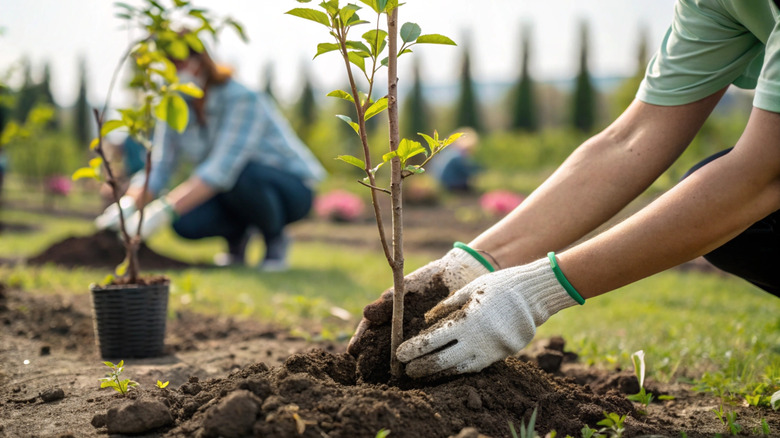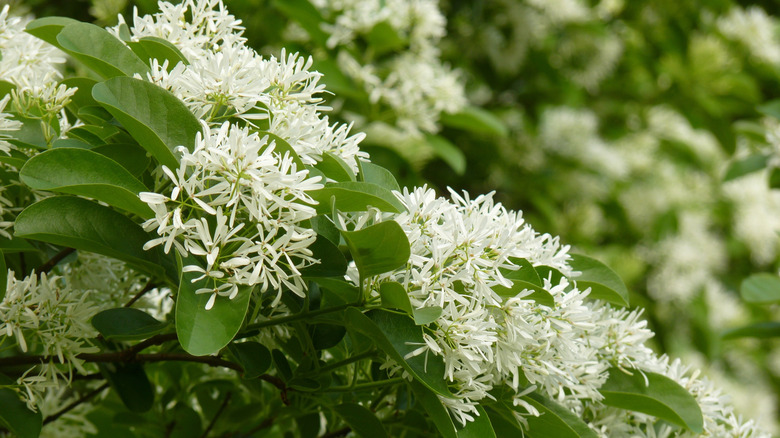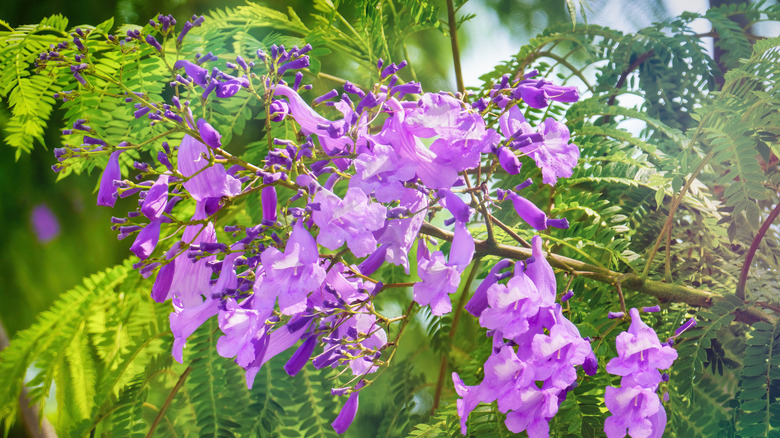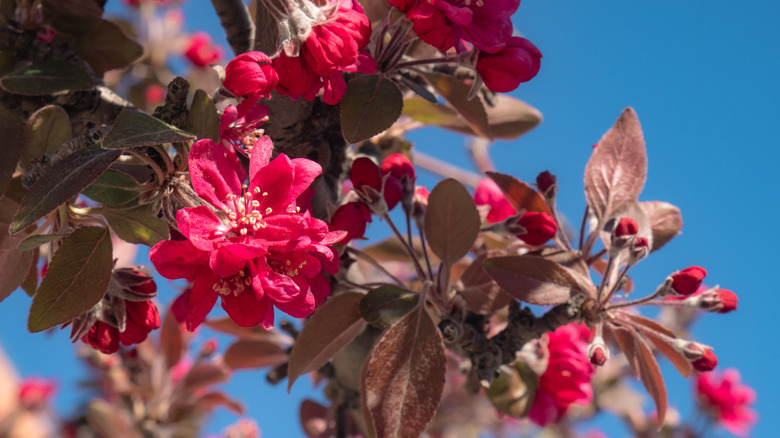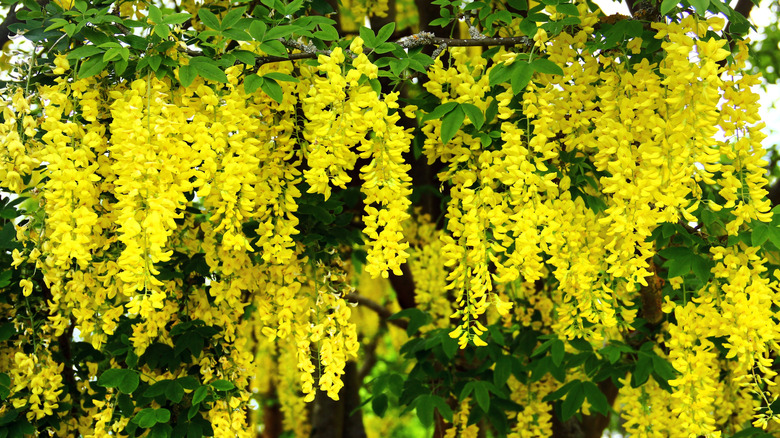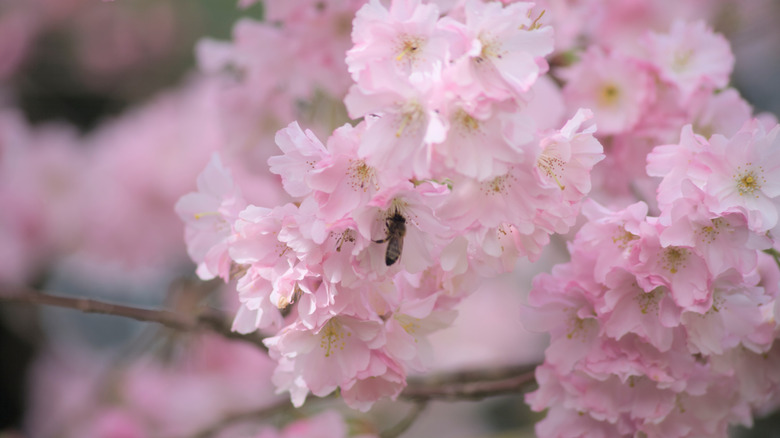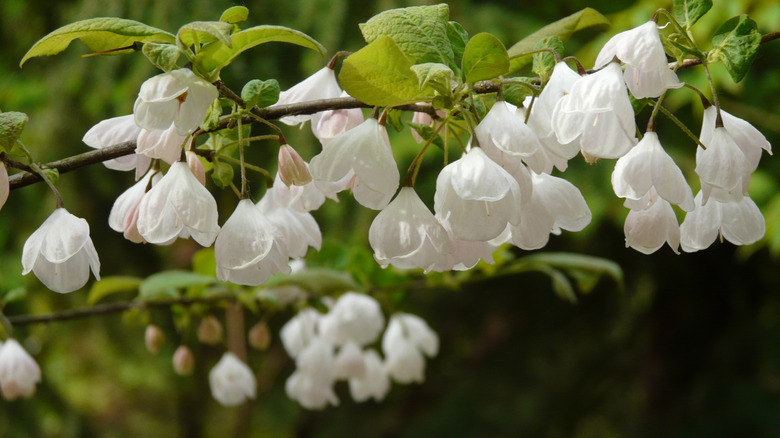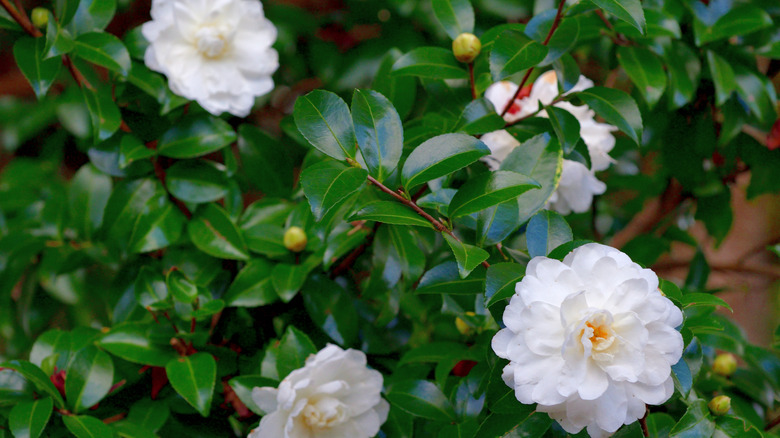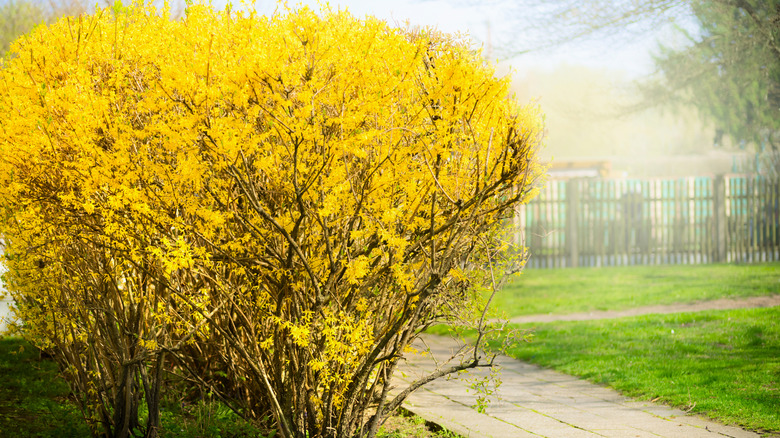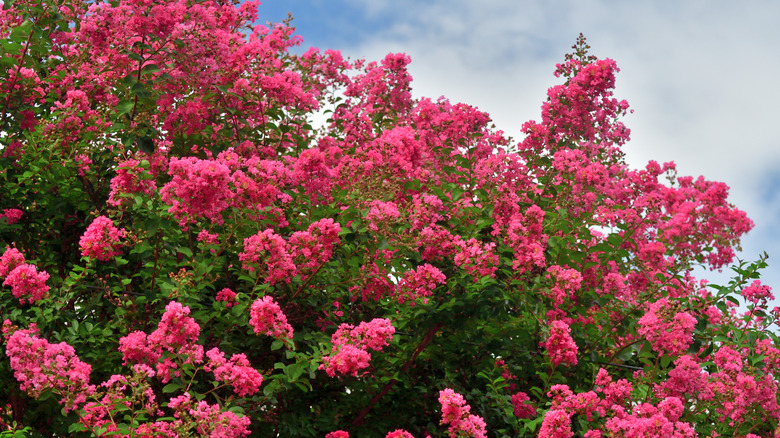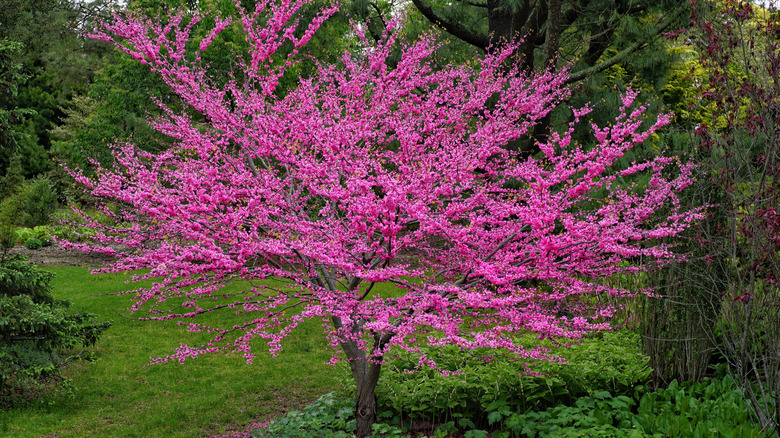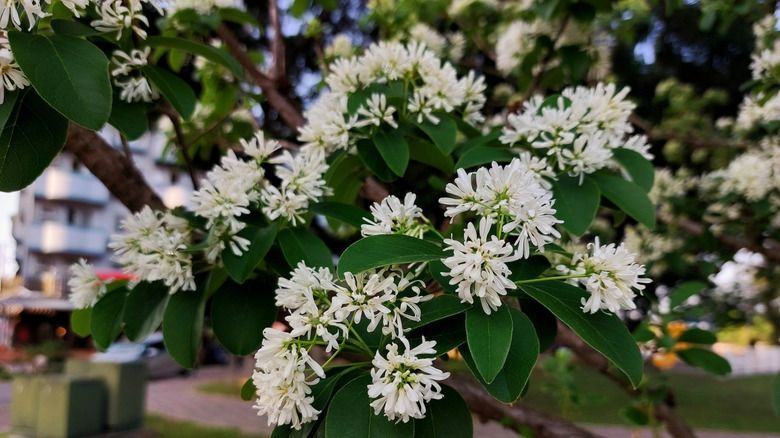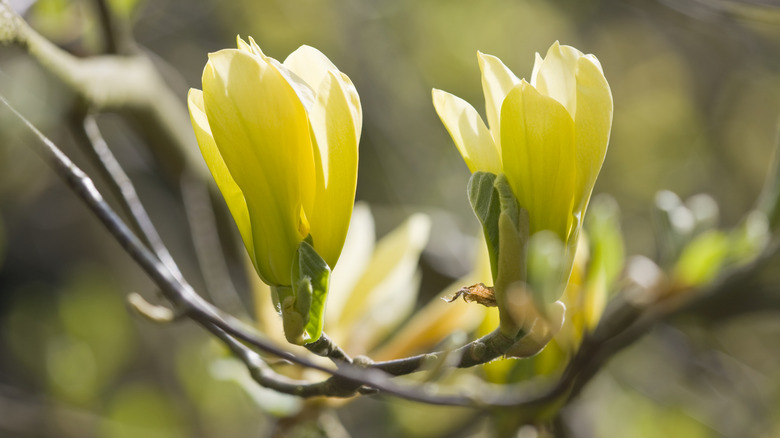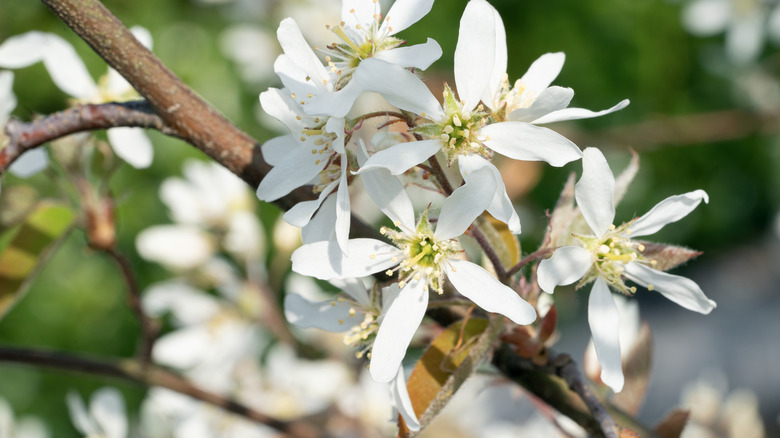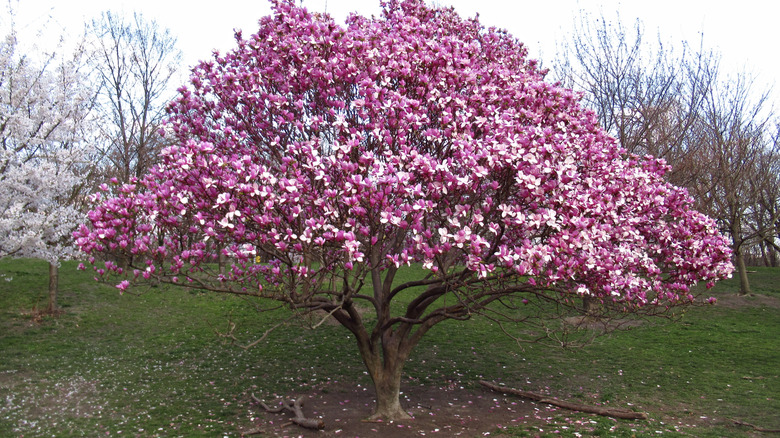The 14 Longest-Blooming Flowering Trees To Grow For Dazzling, Lasting Color
We may receive a commission on purchases made from links.
Whether your goal is to plant flowering trees that'll attract hummingbirds to your yard and garden, or you simply love flowers, planting trees that flower is the best way to flood your outdoor living area with vibrant color. Picking out the right combination of trees will give you a rolling blaze of flowering beauty that lasts for months.
If you're worried that your garden is too small for a tree, fear not! There are many flowering trees that are on the smaller side, making them perfect for compact gardens. Others are well-suited to urban conditions, making it possible for city dwellers to benefit from the beauty of a tree crowned in colorful flowers as much as those who enjoy a rural lifestyle. Nothing softens a harsh cement landscape as effectively as a tall, stately, flower-laden tree.
Once you've picked out and planted the trees you want, paying attention to their needs keeps them growing strong, and a thriving tree produces many flowers. Keeping your soil well-fertilized can also help maximize the flower show your trees put on. While each tree may have its own requirements, a general fertilizer such as the Gardenera Professional Fertilizer can feed them and result in many flowers and the longest flowering season possible.
Chinese fringe tree
The Chinese fringe tree (Chionanthus retusus) is a deciduous tree that bears delicate puffs of small, creamy white flowers that fill the air with fragrance from late spring to early summer. As the flowers fade, they release their petals, casting a snowy covering on the ground. Growing to height of 10 to 20 feet, this low maintenance tree loves full sun or partial shade and doesn't cope well with drought. City dwellers in zones 5 to 9 can invest in this tree as it's not affected by air pollution. Birds love the fringe tree fruit.
Jacaranda tree
By planting a jacaranda tree (Jacaranda mimosifolia)in your yard, you'll be welcoming 50 years of an extravagant lavender-blue shower of flowers from spring to early summer. The delicate trumpet-shaped flowers are vividly highlighted by the backdrop of bright green fern-like leaves. They're fast-growing trees, adding 3 to 5 feet of height a year until they reach between 25 and 50 foot tall. Suitable for zones 10 to 11, they're not widely considered to be invasive, although they are problematic in Hawaii. They can disrupt the environment due to their seeding habits and aggressively growing root systems.
Royal Raindrops crabapple
Flowering from mid-spring onwards, the Royal Raindrops crabapple is a deciduous tree that produces clusters of magenta-pink flowers in mid-spring. Flowers are followed by dark red fruit, similar to cherries. This crabapple species loves full sun and grows to a height of 15 to 20 feet in zones 4 to 8. Plant Royal Raindrops in your garden as an eye-catching standalone tree as the flowers are set off against striking purple leaves, which turn bronze, orange, and purple in the fall. The only drawback is they're toxic to animals, though birds, bees, and butterflies are drawn to them.
Bean tree
A cultivar of golden chain tree, the bean tree (Laburnum x watereri 'Vossi') thrives in zones 5 to 7 and flowers in late spring. The bright clusters hang in fragrant masses of yellow blooms from arched branches. As a small tree, reaching a height of 25 to 30 feet, they make perfect path-lining blooms to create natural overhead arches that can be trained for pergolas. Plant in full sun to maximize the tree's flowering capacity. All parts of this tree are considered toxic to people and animals. Plant with care as the leaves, flowers, and seeds of this tree are all poisonous.
Japanese flowering cherry
If ever you're looking for pure romance captured in petals on branches, the Japanese flowering cherry is it! Prunus 'Kanzan' is a generous small tree, spreading wide its branches and filling them with a profusion of delicate shell pink flowers in dense clusters. Dark pink buds appear early on in spring, opening to extravagant semi-double petals that cover the tree through to summer. Once you've nailed the best growing conditions for a thriving cherry blossom tree, you'll have delicate romance in your zone 5 to 9 garden. Dark green leaves replace the flowers, which blaze orange through fall.
Carolina Silverbell
Commonly known as the Carolina silverbell, Halesia carolina is the tree of faerie legends with its delicate white flowers that hang like miniature ballgowns off slender branches. Best suited to zones 4 to 8, this tree flowers in mid-spring. While it tolerates being in the sun, it grows better in part-shade. When conditions are right, this tree easily lives on for 100 years, producing it bountiful crop of flowers for bees, which are replaced by pale green fruit during autumn. Plant it along the banks of a stream to reflect in the water, doubling the appeal.
Camellia
While most trees flower in spring or summer, the camellia is an exquisite cold weather flowering shrub that can be pruned into a small tree. Growing only as tall as 6 to 10 feet, camellias are shade-lovers who start to bloom in autumn and continue through winter in zones 7 to 9. The flowers are extravagant double blooms up to 3 inches wide, and an average plant produces masses of blossoms – a spectacular show! Below zero temperatures can kill a camellia, so it needs some protection from the elements, even though it's a cold season bloomer.
Forsythia
If your zone 5 to 9 garden needs a bright splash of yellow at the start of spring to wake up a winter-sleepy garden, forsythia is your go-to. Flowers appear on the arched, bare branches before its leaves and last for a couple of weeks. While it's typically grown as a deciduous shrub, it can be shaped into a tree with correct pruning. Its dense foliage and prolific bell-shaped flowers make it an ideal screening tree that is loved by bees, while the strong root system aids in preventing soil erosion. Height varies according to the variety you plant.
Crape myrtle
Filling in the late summer, early fall flowering gap, you'll find the crape myrtle (Lagerstroemia indica). Natural varieties have rose pink or red flowers that form in abundant clusters in a striking shades that contrast beautifully with the glossy leaves. These are most happy in zones 6 to 9, where you can prune to a tree shape in late winter or early spring. For the best show of flowers, plant your crape myrtle where it gets a minimum of 6 hours of direct sunlight daily. This water-wise tree is drought-tolerant once it's well-established.
Eastern redbud
The eastern redbud (Cercis canadensis), is a must-have splash of vivacious color covered in small pink flowers early in spring, giving way to heart-shaped foliage in bright shades of orange and lime green in summer, which turn yellow in the fall. Growing to heights between 20 and 30 feet, this multi-colored gem is ideal for gardens in zones 4 to 8. This is a relatively easy-to-grow tree that loves full sun or semi-shade and appeals to birds, hummingbirds, and butterflies. As it doesn't transplant well, it's best to plant it where it can remain without being bothered.
Seven son flower
Commonly called the seven son flower, Heptacodium miconioides, can be grown as a large shrub or a small tree, reaching a maximum of 20 feet tall in zones 5 to 9. Flowering in late summer and into fall, your garden will be treated to a prolific display of clusters of trumpet-shaped creamy white flowers. Fragrant and rich in nectar, these flowers draw hummingbirds, bees, and butterflies. The flowers fade to leave behind rose-colored leafy calyces to protect fruits that are purple to red in color, which are just as striking as the flowers.
'Yellow bird' magnolia
Magnolia trees don't just come in white, purple, and pink. 'Yellow Bird' magnolia (magnolia x brooklynensis 'Yellow Bird') produces citrus yellow flowers in late spring that are shaped somewhat like tulips. The tree thrives for those who live in zones 4 to 8, producing a vast spread of golden yellow flowers, with each bloom lasting up to three weeks. The tree can reach heights of 20 to 40 feet. Magnolias love moist, but well-drained soil, slightly on the acidic side. The flowers from this tree can be cut and used in bouquets that fill rooms with their scent.
Juneberry
Native to North America, juneberry (Amelanchier lamarckii) can be grown as a shrub or shaped into a small tree across zones 4 to 8. Flowering in mid-spring with abundant sprays of small, delicate, star-shaped flowers that are lightly scented and loved by bees and birds. These give way to dark berries in summertime that are popular for making jam or baking into pies. They thrive in full or partial sun, in soil that is damp and well-drained. Mature trees can reach heights of 15 to 25 feet.
'Nigra' lily magnolia
Magnolia lilliflora 'Nigra' is the pink and purple magnolia tree variety you'll want to plant for beautiful blooms. An ideal showstopper for small gardens in zones 5 to 8, it will grace your garden with a stunning display of pale pink to reddish-purple, tulip-shaped flowers throughout spring and possibly into summer. To ensure healthy buds and flowers, aim to plant it in a space protected from cold, dry winds. They'll reach a height of 8 to 12 feet and are often as wide as they are tall, with flowers that attract birds and butterflies. They don't like soggy soil.
